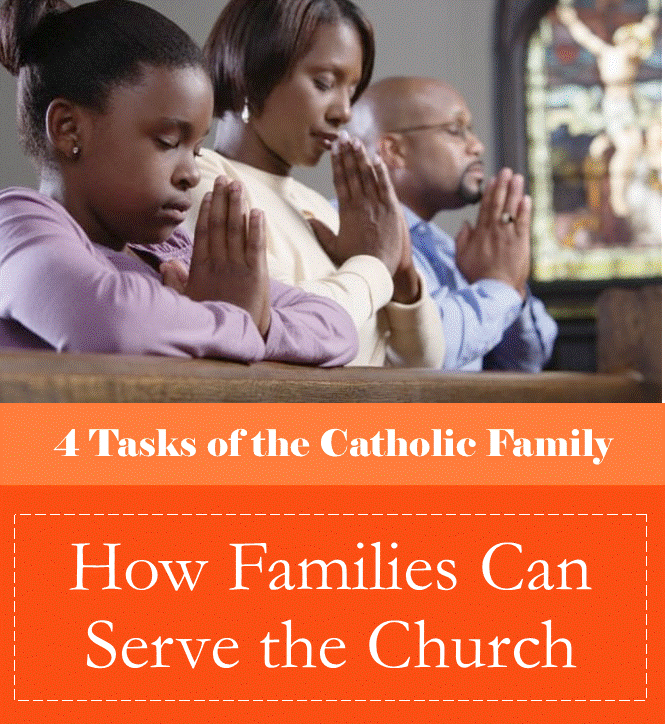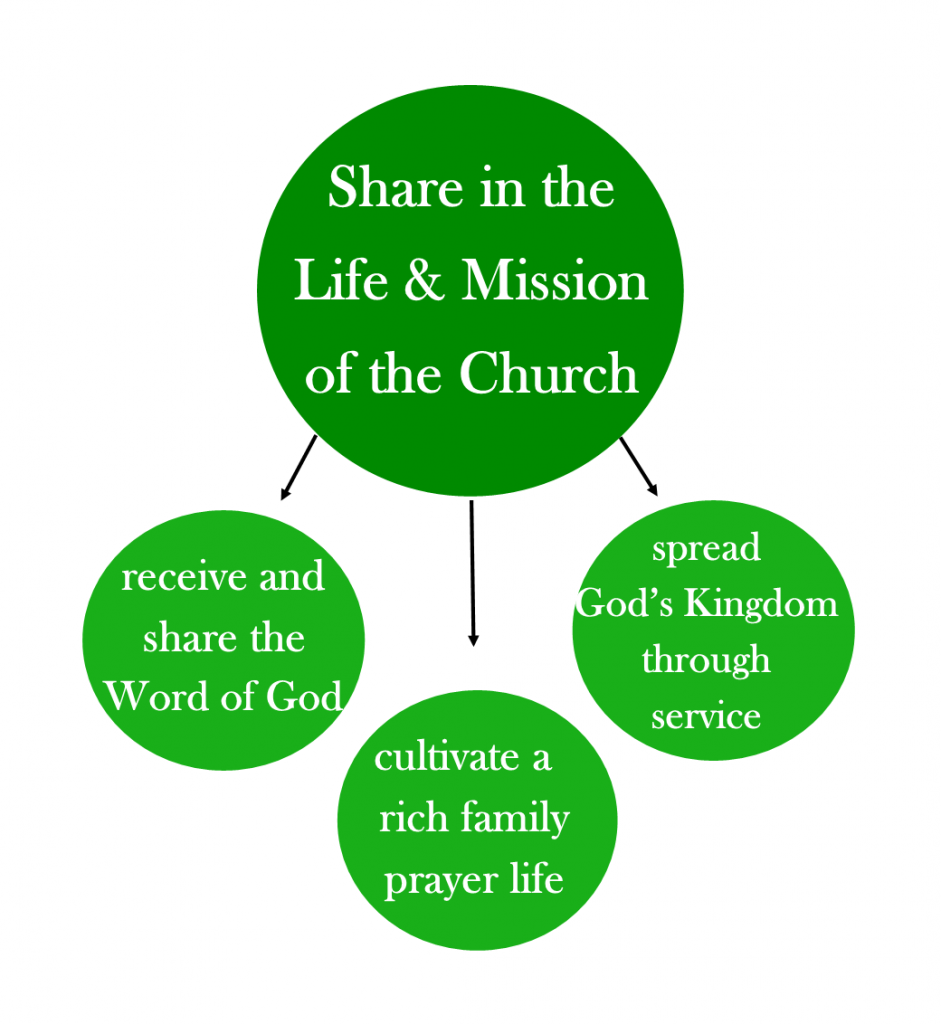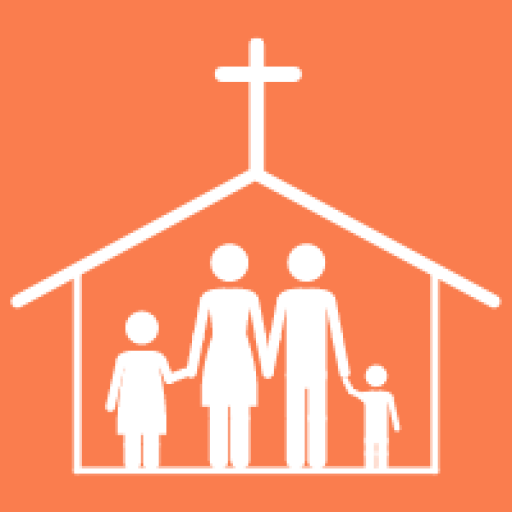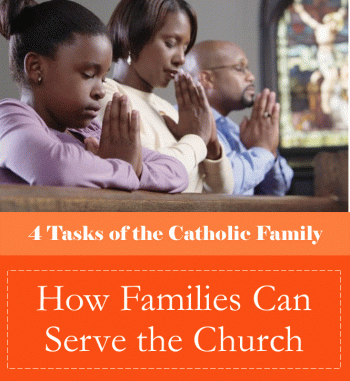
4 Tasks of the Catholic Family Series
- Build Your Community of Love
- How Families Can “Serve Life”
- How Families Can Change Society
- How Families Can Serve the Church (this article)
*Free infographic of the 4 tasks down below! Woo hoo!
***
In this article series, I’m exploring the four tasks of the Catholic family as St. John Paul II outlined them in Familiaris Consortio. These four tasks clarify how we can express and live our identity and mission as Catholic families. I’ve covered the first three tasks in previous articles:
- Our first task is to build a community of love through caring for one another and healing divisions.
- Our second task is to serve life by welcoming, nurturing, and educating our children.
- Our third task is to participate in the development of society by practicing hospitality, becoming politically involved particularly when issues impact families, and practicing the works of mercy.
To express our family’s mission, our fourth task is to share in the “life and mission” of the Church. When I first read the topic of this task, I assumed the pope would encourage us to get involved in parish ministries and to support our priests. He says much more!
Here’s a way to understand it: Our families have not only a private mission of serving and loving one another; we have not only a social mission of serving our communities and engaging in political life: we have an ecclesial mission. The fourth task involves this ecclesial mission. We are the domestic church, which is a “living image and historical representation of the mystery of the Church” (FC 49). We serve the church and participate in Her mission to transform culture through activities connected to our prophetic, priestly, and kingly roles in God’s kingdom.
Receive and Share the Word of God (Prophetic Role)

Families serve the Church by receiving, believing, living, and announcing the Word of God in our homes and beyond. This is an aspect of our prophetic role in the Church: we are called to spread the Gospel to the world.
The Church needs our families to take to heart this call to evangelize. In fact, “the future of evangelization depends in great part on the church of the home” (FC 52). We begin by evangelizing our children, a ministry the pope calls “original and irreplaceable.”
Many of us feel ill-equipped for this duty; we aren’t sure how to transmit our faith to our children. My book is a good place to start for inspiration! You are the answer to what your child needs to grow in faith. You don’t have to have all the answers if you become the answer to her longing for love, acceptance, and belonging. In every family, even by our example of fidelity and love, by our commitment to building relationships, by our works of service, we evangelize our kids.
Family Catechesis. You don’t need to know everything, but it’s fun to explore the Faith with your kids. The pope talks about “family catechesis” – our family together can learn about, celebrate, and live the Faith together. There are so many resources to kick start your family catechesis, I hardly know where to start. Celebrating liturgical feasts and saints days, learning about the virtues together, honoring sacramental anniversaries (the day of your child’s baptism, First Communion, etc.) are beautiful ways to share your love for the Faith with your children, and you can find ample resources online. If your kids are all older, I think learning some apologetics together is a good idea. Fr. Mike Schmitz is very popular with youth, but you can find plenty of books, programs, movies, and games to keep you busy.
In this task, the pope is talking about receiving, living, and announcing the Word of God in our homes, so let me offer some concrete suggestions for family scripture study.
Scripture Study
- If you have small children, you might begin reading a children’s Bible together every morning or evening. This one by Lawrence Lovasik with its vintage illustrations is my personal favorite, but there are many good options. Ask your children questions about the stories you read in the Bible. What do you think Abraham packed for that big trip? What do you think Mary and Joseph thought when they realized Jesus wasn’t in the caravan? This helps the children put themselves in the story and feel connected to the events.
- If you have older children, you might do the Encounter scripture study program from Ascension Press. I did it with my kids, and we all learned about how God is always active in history — and we’re part of it! Encounter is marketed as a middle school program, but I found it was perfect for my kids in elementary, middle school, and high school to do together.
- For family movie night, my family loved The Bible epic mini-series. (If you don’t want to purchase it, I believe it’s available on Netflix, but we no longer have a Netflix subscription.) My youngest was unsettled by some of the violence, so if you have kids younger than 8, you might choose some of the Bible cartoons on Formed, Minno, or PureFlix.
Cultivate a Rich Family Prayer Life (Priestly Role)
The priesthood of our family is exercised primarily through our prayer life and our participation in the sacraments.
Prayer. Pope John Paul II describes the unique quality of family prayer: it is in common and in private; its object is family life itself — a life in which we spouses try to work out our response to God’s call on our lives on the day we were married (FC 59). Our families can pray for and through the sorrows and joys, hopes and disappointments, ruptures and reconciliations that happen in our families, often in the course of a single day!
Pope John Paul II urges parents to teach their children to pray to and worship God. He asks us to introduce our children “to gradual discovery of the mystery of God and personal dialogue with him” (FC 60). The pope also mentions the “example and living witness” of the parents in teaching kids to pray. When we pray ourselves, when we turn to God in prayer in times of distress and moments of gratitude, when we express gratitude for prayers answered, we show our children that God is interested in their lives and responsible for the blessings they enjoy.
The Eucharist. More than anything, our family life should be centered around the Eucharist, the source of our strength. The most important work we do as priest-parents is to teach our children to love and reverence the Eucharist and to understand the Real Presence of Jesus.
If you’re looking for a way to explain transubstantiation to young kids, Lacy at Catholic Icing has a great idea for an object lesson using a ball. Small kids really won’t understand the concept well, but it’s still worth introducing the idea. This animated short from Catholic Kids Media does a good job explaining it for slightly older kids.
To help your little ones get excited about receiving the Body and Blood of Jesus someday, this book by Kimberley Fries (Receiving Jesus for Little Ones) looks wonderful. To help older kids understand why the Eucharist is so important to us, I love this book from Jared Dees, one of my favorite catechists. His book would make a great read-aloud; it includes discussion questions.
The most powerful way to instill a respect and love for the Eucharist in our kids is through our example. If we’re quiet, reverent, and point our children toward the altar at the elevation, no matter how young they are they will begin to understand that something amazing is happening.
Spread God’s Kingdom through Service (Kingly Role)
As the domestic church, we fulfill our kingly role by spreading God’s kingdom of truth and life, his kingdom of holiness and grace, his kingdom of justice, love, and peace:
“The Christian family is inspired and guided by the new law of the spirit in intimate communion with the Church, the kingly-people . . . Just as Christ exercises his royal power by serving us, so also the Christian finds the authentic meaning of participation in the kingship of Lord in sharing his spirit and practice of service to man” (FC 63).
How do we do this? By serving like Christ: with love and humility. Parents exercise their kingship by responding generously to their children’s legitimate needs for affection, acceptance, and warmth. They serve with love when they guide their children in living uprightly, simply, and humbly; when they teach them to share their gifts and talents; when they mentor them in helping with household work.
What does this have to do with our ecclesial mission? How are we serving the Church through serving our kids? Because our children will grow up to be kingly Christians themselves, ready to serve as Christ served. The pope says:
“The family must educate the children for life in such a way that each one may full perform his or her role according to the vocation received from God. Indeed the family that is open to transcendent values . . becomes the primary and most excellent seedbed of vocations to a life of consecration to the Kingdom of God” (FC 53).
Many daily activities seem unimportant: doing laundry, feeding children, caring for ill or distraught children, helping kids with math, teaching a child to tie his shoes. But these tasks, when offered to God in love, are transformed into Christ’s presence in our homes.
Of course, serving the Church also includes offering our time to our parish! Our families can help to build and sustain community, support our parish priests, and engage in the charitable works of the Church. Volunteering as a family at our parishes to organize movie nights, liturgical celebrations, and multi-generational catechetical events will change our family and build our Church.
When we focus on serving each other and the Church, our families become conduits of peace and justice. We speak the truth with love; we invite mirth and play; we encourage one another in holiness; we hold one another accountable; we forgive one another more easily; we celebrate and mourn together. In these ways, we mirror Christ’s patient and joyful love for his Church.
The Family Is Both a Safe Harbor and a World Changer
Throughout the “four tasks” section of Familiaris Consortio, Saint Pope John Paul II emphasizes the social aspect of even private family activity. When we offer and protect love in our homes, when we nurture our children through education and moral formation, we are building society. Some readers of Familiaris Consortio overthink the term “social mission”; they interpret the four tasks as warning families against becoming “private havens” (a term used by one scholar). They seem to assume that if a family is a haven for its members then it can’t fulfill its social mission. In fact, the opposite is true.
If the family fails to become a private haven (“safe harbor” is the term social scientists use), then it will be crippled in fulfilling its social mission. Poets dream of home because it is our primary space of rest and safety; it is where we grow roots and wings. We have a special fidelity to our spouses and children, a heightened duty to protect and nurture the bonds of love in our homes.
I searched through Familiaris Consortio, and the pope nowhere suggests this division between haven and mission. Of course, they are complementary. Indeed, the pope frequently begins by directing spouses to nourish their relationship and their children’s emotional, intellectual, and spiritual lives; only then he invites them to turn toward the ecclesial community and the wider world. (See for example FC 121: “It should be so especially between husband and wife and within the family, through a daily effort to promote a truly personal community, initiated and fostered by an inner communion of love. This way of life should then be extended to the wider circle of the ecclesial community of which the Christian family is part.”)
Our families need to be a safe haven for one another if we have any hope of living our mission in the world. The love of family provides a safe harbor when the storms of life become too big. It’s from the safety and rest of this protective harbor that we build enough courage and resilience to take up our family’s social and ecclesial missions.
Free Infographic of the 4 Tasks!
I had fun making this infographic bringing together the 4 tasks!


